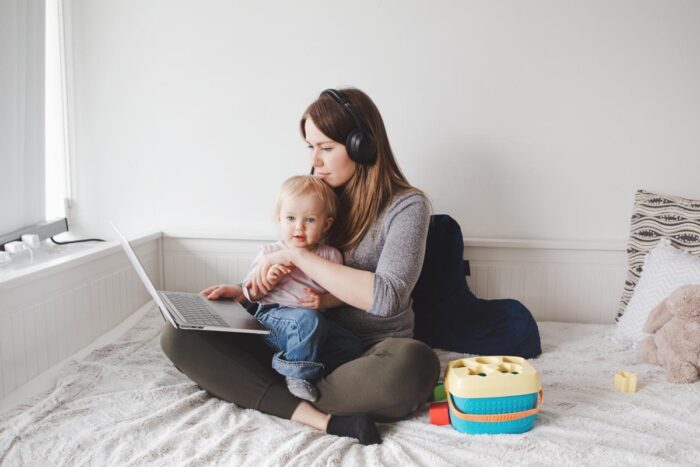It can be a daunting task for single moms to raise children and earn a substantial amount to survive at the same time. There are various options available for financial aid for low-income single mothers if they struggle to make ends meet, are unable to find employment, or have no viable housing options available. They may seek help in times like these from the government in form of grants or the assistance from various charities.
Single Moms Financial Aid Programs
One can get financial aid for mothers from government programs and charities. Note that there is a difference between the amount of money offered by the financial aid options for single mothers mentioned below. Read on to find out more about them:
Government Assistance
You may qualify for government assistance if you have children under 18. Free school lunches, food stamps, Medicaid, and housing subsidies are included. However, these financial aid grants for single mothers require certain qualifications, and assistance will be available if you meet them. Furthermore, state-run programs may provide additional assistance. Various forms of assistance are available, such as cash grants and tax credits.
Charity Assistance
There is also the possibility of charity assistance. An organization providing charity assistance is typically a church, school, or community. The financial aid single mom amount depends on their family size and income level. Some charities even provide childcare for free.
Government Assistance Programs
There are specific requirements for qualifying for government assistance programs, including:
- You must live in poverty
- You must be within the program's age range
- You must also be an American citizen or legal resident
1. Supplemental Nutrition Assistance Program (SNAP)
As part of the SNAP program, low- and no-income families are offered affordable and healthy meals. It is an essential component of the social safety net in the US. Most Americans with low incomes depend solely on SNAP for income support.
A nutritionally adequate diet was made affordable to over 40 million low-income Americans through SNAP, especially for children under 18. To determine eligibility, SNAP applications must be filled out and returned to a local SNAP office by mail, fax, or in person.
SNAP Cash Benefits
In the average month, people received $121 in SNAP benefits, which totaled $4.00 per person per day. The COVID-19 public health emergency has temporarily increased SNAP benefits since April 2020. A higher TFP and recent inflation in food prices will result in SNAP benefits per person averaging about $186 per month in the fiscal year 2023 after the likely end of temporary measures.
SNAP benefits were increased for 37 states as part of the Emergency Assistance (EA) program as of 12 January 2022. The USDA approved an increase in SNAP payments for residents in those 37 states this month.
SNAP Eligibility Criteria
Federal rules require households to meet three criteria to qualify for benefits:
- Must generally have a gross monthly income below 130% of poverty before deductions are applied
- Households must have net incomes below the poverty line after deducting all expenses
- Certain limits on what can be owned — if there is no elder or disabled member in the household, assets must be $2,750 or less; if there is one, assets must be $4,250 or less
2. Women, Infants, and Children Program (WIC)
During pregnancy, new mothers and children under 5 considered "at nutritional risk" can benefit from free healthy foods made available through the WIC nutrition program. In most cases, recipients are eligible to receive benefits for only six months to a year, and then they must reapply. The program gives women $11 monthly to purchase fresh fruit and vegetables and $9 for children.
WIC Eligibility Requirements
TANF recipients are usually prioritized over other applicants based on their nutritional risk and income below 185% of poverty. People who qualify for assistance under the WIC program include:
- Women
- Women who are pregnant or who have given birth to an infant (up to six weeks after the birth or termination of the pregnancy)
- Following the birth of a child or the end of a pregnancy (up to six months after delivery or termination of the pregnancy)
- Breastfeeding (until the child reaches one year of age)
- Newborn infants (until their first birthday)
- Children (until the day they turn five)
The WIC Program also has the following eligibility requirements:
- Must be residing in the state where they are applying. There are residency requirements for applicants served by ITOs when the ITO administers WIC
- Must comply with the federal poverty guidelines (issued annually by the Department of Health and Human Services) and not exceed 185%
An income eligibility for WIC can be determined based on the programs an applicant participates in:
- Benefits applicable to SNAP recipients, Medicaid recipients, and Temporary Assistance for Needy Families recipients
- They may also be eligible for some state-administered programs
3. Child Care Assistance Program (CCAP)
Low-income families participating in the CCAP program receive support from the Child Care and Development Block Grant, which helps them pay for child care while they work, look for jobs, or attend school. In most states, families receiving childcare assistance are expected to pay co-payments based on a sliding fee scale that rises as income increases.
CCAP Eligibility Requirements
When delivered by a CCAP-approved childcare provider, families earning less than 200% of the Federal Poverty Level (FPL) may qualify for full or partial reimbursement for childcare expenses. These can be reimbursed through the CCAP in one of two ways. CCAP is available to families with working parents or those with parents enrolled in approved education and training programs or college degree programs.
4. Child Care Access Means Parents in School Program (CCAMPIS)
Only one federal grant program provides campus-based childcare for low-income parents in postsecondary education: the Child Care Access Means Parents in School Program (CCAMPIS). Lower-income student parents will be supported by this program to maintain their education and graduate from college, but most will be placed on a waitlist.
CCAMPIS Eligibility Criteria
The CCAMPIS funding program evaluates applications for child care assistance based on their eligibility status, financial income, financial need, resources, and level of family contribution. A low-income parent with a Pell Grant is eligible to participate in this program.
5. Head Start / Early Head Start
It promotes "school readiness" for children between birth and five by providing both Head Start and Early Head Start services. Head Start and Early Head Start are programs for children from birth to two years of age, while Head Start is for children from three to five years old. From health and nutrition education to free medical and dental care to even the involvement of parents in the family, this organization offers a wide range of services.
You should apply there if you live in a community with a Head Start or Early Head Start program. American Indian and Alaska Native children can also take advantage of over 150 Head Start programs.
Head Start Eligibility Criteria
Family income must be at or below the poverty line to be eligible. Applicants must also meet the following eligibility requirements:
- Children must be between the ages of three and five from low-income families, according to the federal poverty guidelines
- Can be foster children, homeless children, and children from households receiving public assistance (TANF or SSI)
- From a family with an income above the poverty guidelines
- From a family with incomes over the poverty guidelines but below 130% of the poverty line may also be served by programs if certain conditions are met
- Can be pregnant women
6. Section 8 Rental Subsidy
Assisted housing programs like Section 8 help low-income families obtain safe and decent housing. Rent vouchers are provided to very low-income families, homebound individuals, and the elderly.
Generally, 70% of rent and utilities are funded by a voucher, but renters must pay the remaining 30%. For example, the voucher is worth about $440 per month for a single mother with two children who rents an apartment for $700 and works 30 hours a week at minimum wage.
Section 8 Eligibility Requirements
Based on the following factors, the PHA determines whether a person is eligible for a housing voucher:
- Gross income for the year
- Size of the family
- Citizenship of the United States and specified categories of noncitizens with an immigration status that meets certain criteria
- Families living in a county or metro area with median income below 50% of the family's income
Applicants whose incomes do not exceed 30% of the area median income are entitled to 75% of a PHA's vouchers. The median income levels vary by location and are published by HUD. In your community, the PHA that serves your area can help you determine the income limits based on the size of your family.
7. Temporary Assistance for Needy Families (TANF)
Families with low incomes rely on TANF to provide them with safety. In addition to providing short-term financial assistance and job opportunities, it aims to help these families achieve self-sufficiency. Grants for the TANF program are categorized into two types: grants for children only and grants for families.
- Child-only grants cater only to the child's needs. For one child, about $8 per day would be awarded
- There’s a possibility to receive a "family grant," which some consider the easiest to obtain of the two TANF grants
The program provides a small amount of cash to help people with food, clothing, shelter, and other essentials for up to 60 months. However, many states limit the duration of the program to a shorter period.
TANF Eligibility Criteria
An unemployed single mom who meets the following eligibility criteria can receive TANF assistance:
- With a child under 19 years of age or is pregnant. If a child is 18 years old, they must be a full-time high school student. Pregnant women (and their husbands, if they live with them) may qualify for assistance
- US citizenship or immigration requirements are required. It is possible to qualify even if you are homeless
- Have a developed plan and follows it
Charities & Non-profits
Charitable organizations and non-profits can provide single mothers with financial resources. Single-parent assistance is available across the country through several charities and non-profit organizations. They can assist you with childcare, wellness programs, job training, food resources, and provide free car grants to assist you in taking your children to school.
Charities and non-profit organizations that assist single mothers include:
If you are interested in learning more about different grants and programs that can help you with your living situation, read our blog post on free government grants for dental implants.







